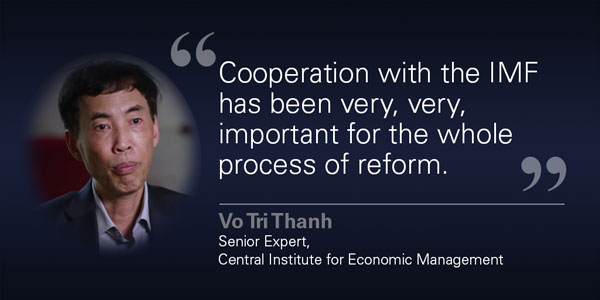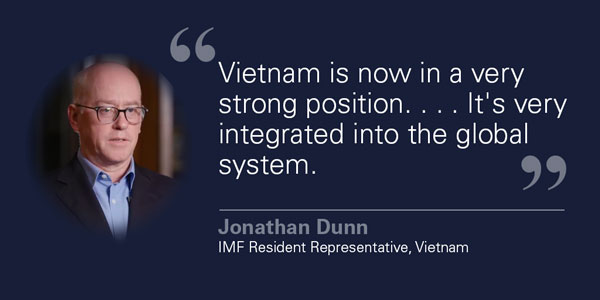Vietnam: Raising Millions Out of Poverty
August 2018
The early 1980s were a bleak period for Vietnam. The southeast Asian country, one of the world’s poorest, was still recovering from decades of war. Its centrally planned economy was unable to deliver basic consumer goods. Inflation was running at 400 percent. Cities were regularly darkened by power outages.
“Those were really tough times back then,” recalls Mai Kieu Lien, who runs one of the country’s biggest food processing companies. “We were dependent on external aid. Everything was subject to stamp rationing – rice, meat, everything.”
Things began to change for the better in 1986, with the start of an ambitious program of economic reform known as Doi Moi, or renovation. Within a few years, television sets and washing machines appeared in shops from Hanoi to Ho Chi Minh City. Private enterprise flourished, and foreign investment flowed in. Vietnamese started to travel broadly as the country rejoined the global economy.
Vietnam’s remarkable journey from low to middle-income status lifted 40 million people out of poverty between 1993 and 2014. In that time span, the poverty rate dropped to 14 percent from almost 60 percent. Per capita growth since 1990 has been second only to China’s, averaging 5.6 percent a year as of 2017. Vietnamese are now better educated and can expect to live longer than citizens of most countries with similar income levels. Almost every household has electricity, up from less than half in 1993.
International assistance
The country’s transformation was very much the product of the determination of its leadership and the hard work of its people, who now number 95 million. Along the way, the country sought and received financial and technical assistance from foreign governments and organizations, including the Asian Development Bank, the World Bank, and the International Monetary Fund. Advisers from the IMF have helped Vietnam improve public administration, tax policy, central banking, and statistics gathering. IMF assessments of the economy help Vietnam improve its credit rating, which draws foreign investment.
“Cooperation with the IMF has been very, very, important for the whole process of reform,” says Vo Tri Thanh, a senior expert at the Central Institute for Economic Management of Vietnam.
In the 1980s, the country was in dire economic straits. Job number 1 was to stabilize the economy, which meant easing price controls, raising interest rates, limiting subsidies to inefficient state-owned enterprises, and devaluing Vietnam’s currency, the dong. By 1993, inflation had fallen to an annual rate of around 8 percent, from 300-400 percent per year in the mid to late 1980s.
“Without macro stability, you cannot have a good record of poverty reduction,” Thanh says.
Next, the country moved toward a system of private ownership, starting with its biggest sector, agriculture. Cooperative farms were dissolved and households given rights to land. With market incentives in place, food production soared. The government laid the legal foundations for privately owned companies and gave state enterprises more freedom to make decisions on production, hiring and prices.
The final piece of the puzzle: opening the long-isolated country to foreign trade and investment. Vietnam desperately needed foreign capital and know-how to develop its economy and create jobs. It also needed to give its own companies the chance to sell their goods abroad. With those goals in mind, the country joined the Association of Southeast Asian Nations in 1995 and signed numerous regional and bilateral trade deals following its accession to the World Trade Organization in 2007, which was a watershed that stimulated much larger inflows of foreign investment.
Foreign investment
“From a very, very, closed economy, now Vietnam has become one of the most open economies among the developing countries, in terms of trade, in terms of FDI,” Thanh says.
By ending restrictions over trade and foreign investment, Vietnam attracted companies like South Korea’s Samsung, which saw the country, with its well-educated workers and low wages, as an attractive platform for manufacturing and exports.
“The labor force of Vietnam is very excellent,” says Ha Chan Ho, a strategic adviser to Samsung. “The people are very hard working and diligent.”
Samsung started manufacturing mobile phones in Vietnam in 2009. It now has three plants in the north turning out mobile phones and display panels and one in the south making washing machines and TVs. Samsung has invested $17.5 billion in the country and employs 160,000 people.
Vietnamese companies, private and state-owned, have also flourished. Vinamilk, which started as a small dairy operation in 1976, is now the domestic industry leader with 15,000 employees and annual sales of about $2 billion, of which a quarter are exports. It has investments in Cambodia, New Zealand, Poland and the United States. Vinamilk was floated on Vietnam’s stock exchange in 2003, though the state still owns a large stake.
New businesses
“We used to be totally dependent on the state,” says Lien, Vinamilk’s chief executive. “Now that the state has decided to give us autonomy, we have full discretion to do business according to the strategy that we have drawn up. That creates a strong motivation for businesses to grow.”
As early as the late 1980s, new quasi privately-owned businesses began to appear. Among them was FPT Corp., founded by Truong Gia Binh—a mathematician trained in Moscow—on the foundation of a small state-owned enterprise. In 1988, a former classmate came to him with a plea for help: “Please save my family with a wife and two kids, because salary at that moment was only $5,” Binh recalls his classmate saying. He got together with 12 other scientists, “and we decided to set up FPT.”
In 2006, the company was listed on Vietnam’s stock exchange. As of 2017, it had sales of $2 billion and employed almost 30,000 workers.
There have been bumps along the road. Most recently, a credit-fueled expansion in 2011-12 was followed by a real estate bust and a slowdown in economic growth. While growth has picked up again, the episode was a reminder of the importance of sound economic management, particularly as Vietnam’s greater openness leaves it more vulnerable to external shocks.
And while Vietnam continues to make huge strides, it still faces significant challenges. Rapid economic growth has resulted in polluted air and water and deforestation. With a high proportion of its people concentrated along its 3,260-kilometer (2,2026-mile) coastline, Vietnam is among the five countries deemed most likely to be affected by climate change.
Caring for the elderly
Shifting demographics pose another challenge. Vietnam’s population, while still relatively young, will begin to age in a couple of decades. That means the labor force will increase more slowly, contributing less to economic growth. Meanwhile, the country will have to bear rising costs of caring for the elderly at a time when per capita income might remain relatively low.
“Vietnam has been enjoying the demographic dividend in the last two decades, but the demographic window is coming to an end,” says Nguyen Thi Hong, Deputy Governor of the State Bank of Vietnam, the country’s central bank.
The solution will be to maintain rapid economic growth by improving productivity—the amount each worker can produce in an hour. That is the aim of the second generation of reforms after Doi Moi. Plans include adding fresh capital to some banks and closing others, restructuring the state-owned enterprises that still account for a large share of the economy, and continuing to streamline business regulations.
“If Vietnam can pursue the second-generation reforms, the country has a chance to match the performance of the most successful Asian tiger countries” such as South Korea and Taiwan, says Jonathan Dunn, the IMF’s resident representative. “Vietnam is now in a very strong position. It has a very dynamic economy; it's very integrated into the global system.”










